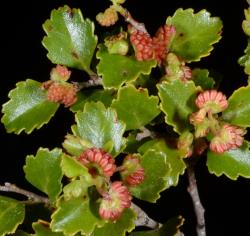- ≡ Nothofagus subgen. Lophozonia (Turcz.) Krasser, Ann. K. K. Naturhist. Hofmus. 11: 162 (1896)
- = Nothofagus subgen. Nothofagus sect. Calusparassus subsect. Menziesiae Philipson & M.N.Philipson, Bot. J. Linn. Soc. 98: 34 (1988)
- = Nothofagus subgen. Menziesospora R.S.Hill & J.Read, Bot. J. Linn. Soc. 105: 69 (1991)
- = Nothofagus subgen. Nothofagus sect. Adenofagus Baum.-Bod., Syst. Fl. Neu-Caledonien 94, 114 (1992)
Evergreen trees up to 40 m high. Stipules non-peltate. Leaves distichous, margin crenate; fimbrial vein complete; large, globular, glandular trichomes present on cuticle; solitary unicellular trichome type A absent; solitary unicellular trichomes type C present, with a large base equal to or greater than the diameter of the trichome and with a large, unicellular, thin-walled trichome emerging. Stomata randomly oriented; without thickened T-pieces of cuticle at the poles separating the two guard cells; without giant stomata over the major veins; stomata size within the areoles variable. Upper epidermal cells over veins not distinguishable from areolar cells, without granular cell walls. Male dichasium a solitary pseudanthium; perianth open and broadly campanulate, asymmetric and irregular; stamens usually >20, developing centrifugally; anthers often slightly curved; distal connective protrusion weakly developed, filament connective free, without epidermal papillae or with isomorphic rounded papillae. Female dichasium with 1 central dimerous flower and 2 lateral trimerous flowers, or 2 trimerous flowers; stigmas clavate and weakly decurrent. Cupule valves 4, with simple trichomes; with rows of stalked appendages, hairy with globular, glandular apices; nuts triquetrous or lenticular, 2- or 3-winged.
Pollen: Peritreme or goniotreme, mesocolpia straight to convex; colpi long, tenuimarginate, with V-shaped ends, margins not thickened, aperture >15.0 µm long, polar to equatorial length ratio 0.35–0.4.
A genus of seven species in Australia, New Zealand, Chile and Argentina. Lophozonia has two endemic species in Australia, four endemic species in southern South America (Chile and Argentina) and one endemic species in New Zealand.
| Category | Number |
|---|---|
| Indigenous (Endemic) | 1 |
| Total | 1 |




